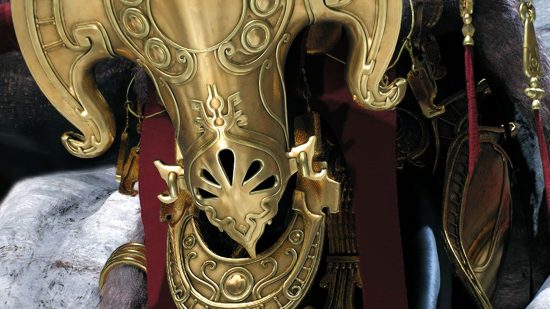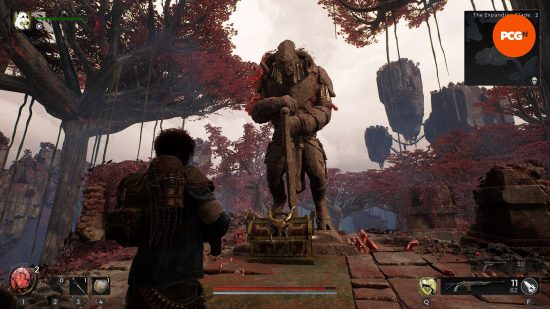Our Verdict
Remnant 2 marries Matryoshka level design and sublime set pieces with memorable bosses, all while polishing the combat system and build customization of its genre-bending predecessor to a spit shine.
Following in the footsteps of its predecessor, Remnant 2 sits boldly yet comfortably at the intersection of multiple genres. Gunfire Games has cherry-picked the best aspects of roguelikes, soulslikes, and looter shooters, to create a compelling patchwork of mechanics that’s quite unlike anything else. It’s also fiendishly easy to approach it with preconceived notions of how Remnant 2 should perform. Those looking for a laidback, arcade-style shooter similar to Borderlands may be brought up short by the presence of invincibility frames and robust enemies, while die-hard souls-like fans may balk at the overwhelming focus on gunplay.
Remnant’s core conceit is traversing a veritable tombola of alien worlds, defeating fearsome bosses, and crafting an eccentric build of wholly incongruous weapons and abilities with a bid to destroy the invading Root, before returning to the sanctuary of Earth’s Ward 13 just in time for tea. Remnant: From the Ashes took slightly too long to get to its world-hopping heel turn, and inadvertently pigeon-holed itself into the brown shooter box as a result. Gunfire Games has clearly learned from the predecessor, instead relegating the crumbling tower blocks and dilapidated streets of post-apocalyptic Earth to Remnant 2’s brief tutorial and hub world, before dragging both new and returning players kicking and screaming into the World Stone.
An entire universe may be on our doorstep, but Gunfire Games has resisted the urge to expand the number of available realms to explore in its sequel. Instead, Remnant 2 includes five distinct realms that are staggeringly dense, boasting exquisite world design that make them a joy to explore. The desolate N’Erud evokes H.R. Geiger via nightmarish facilities teeming with all manner of biomechanical, alien horrors. Meanwhile, the sundered realm of Losomn contains the unlikely collision of two wholly separate worlds: cobbled streets crowded with pitchfork-wielding peasants à la Bloodborne, and a fantastical fortress of ornate splendor defended by a fae-like militia. Wherever you end up after you touch the World Stone, the encroaching Root serves as the throughline that ties together this dichotomy of visual design: no matter where you go, it festers and blooms, a constant reminder of your goal.
Much like its predecessor, Remnant 2 grants me the freedom to engage with its world-building on my own terms. While Gunfire Games has put clear effort into establishing the lore of each realm, the vast majority of it is consigned to journals or tucked away in extraneous dialogue options when conversing with NPCs, which I can peruse at my leisure. However, there’s just so much of it that it can occasionally become too arduous to unpack, especially if you’re holding up a co-op partner to try and make sense of it all. You could argue this provides some bonus value to solo exploration, but I can’t help but feel all this flavor text would be more effective if delivered as bite-sized morsels. That said, the politics and history drawn up for each realm is undeniably captivating, and I found myself exhausting dialogue options to untangle the bitter history and grand mythologies of each world according to its leaders. Plus, if you ever want to know how to prepare Yaeshan spiced plums, Gunfire Games has got your back.
Looking closer to home, veterans of Remnant: From the Ashes will be pleased to see many familiar faces return for its sequel. Over two decades have passed, and the ragtag cabal of Ward 13 flirt with more complex relationships than we’ve seen previously, from the blossoming romance between Bo and Clementine to the strained and mercurial relationship between founder Ford and, well, everyone else. However, once introduced, these characters are relegated to merchant status, and there’s no real reason to interact with them beyond discovering what they sell. Even newcomer Cass – our companion, mysteriously afflicted with root rot – is swiftly cured of her ailments and left standing awkwardly in the Ward 13 camp with a meager collection of disparate items, and it’s impossible to ignore the missed potential here.
Remnant 2 is undoubtedly difficult, but it isn’t a superficial exercise in masochism – it’s also a core element of its gameplay loop. No challenge is truly insurmountable, and while it smarts to be brought up short by a relentless boss, it isn’t always a testament to a lack of skill. Instead, these difficulty walls serve as a gentle nudge to take a break from plowing through the main campaign to dip into Adventure Mode instead. This alternative mode draws Remnant’s roguelike elements to the fore, allowing you to reroll previously explored areas for new quests, bosses, and loot in self-contained ‘runs’. It’s a welcome alternative to throwing yourself at a boss over and over until you brute force a victory, and speaks to the density of the worlds Gunfire Games has crafted.
As you might expect, Remnant 2’s extensive RNG creates compelling watercooler moments, especially if you and your co-op partners are partial to solo expeditions. While I clambered into an empty stasis pod in an alien facility in one realm, my co-op partner outfoxed a card-shuffling trickster in a remote palace in another. These moments of revelatory delight occur together as much as they do separately – the horror expressed by my co-op partner as he turned around just in time to see bestial claws drag me through a sewer grate was a particular highlight. Remnant 2 also rewards copious exploration in the form of loot chests and secret bosses, and while you don’t have to stray from the beaten path, it certainly pays to do so.
After shoring up a hoard of anecdotes during Remnant 2’s co-op, returning to solo play made for a strikingly lonely experience. Going it alone fosters a sense of trepidation evoked by traditional souls-likes: I never know what’s coming around the corner, and I’m keenly aware that there’s no one around to revive me if I put a foot wrong. Unfortunately, Remnant 2 is not entirely immune to the combat frustrations that plagued its predecessor, and these become more prominent during solo play. It’s easy to become overwhelmed by enemies while flying solo, and being stun-locked to death is never fun.
On the subject of certain death, Remnant 2’s rogues gallery is fit to burst with a menagerie of twisted aberrations, and a huge step up from that of its predecessor as Gunfire Games leans fully into the possibilities presented by the universe it has created. In the space of a few hours, you might find yourself facing off with a six-legged wolf corrupted by tumescent rot, a gestalt sentinel comprised of enormous stone cubes, or an imposter king held aloft by a retinue of armored fae. Each boss is a set piece in its own right, delivering dramatic, showstopping encounters with unique move-sets and multiple phases. As I brace myself to step through a fog wall for the first time, I truly have no inkling of what could be on the other side.
Of course, you can’t hope to defeat these formidable foes without an arsenal of weapons and abilities to call upon – if you’re a fan of build customization, Remnant 2 has it in spades. Character perks, traits, and skills complement special abilities unlocked by weapon mods, mutators, and relics, leaving plenty of room to discover new synergies as you grow. While your archetype (or class) forms the basis of your preferred playstyle, there’s so much freedom to shape it in whichever direction you choose.
I was immediately intrigued by the melee-focused Challenger, which sticks out like a sore thumb in a third-person shooter. While melee combat is more viable this time around, Remnant 2’s overwhelming focus on ranged combat meant that I often felt hamstrung by my chosen archetype. Thankfully, the debut of the dual archetype system allowed me to branch out from that core focus, rather than write off my character as a lost cause.
Regardless of your preferred playstyle, each archetype begins with a basic loadout of rudimentary rifles and pistols – all of which were unceremoniously dumped in storage the moment I got my mitts on supernatural firepower. I’m particularly fond of Nightfall, a nightmarish long gun adorned with fronds of reanimated fingers that happens to contain the souls of the damned, which scream in unison during a reload.
Weapon mods cannot be overlooked either, allowing me to summon a cursed mirror that inflicts madness on any enemies that cross its sightline, or pulsing electrical orbs that drift lazily across the battlefield. With all this weirdness on offer, I often find myself rushing back to Ward 13 after defeating a boss just to see what I’ve unlocked. The material cost to craft and upgrade them all is the only drawback, restricting my scope for experimentation on the fly, especially since you can’t sell them back for those materials.
As an aside, Gunfire Games has opted to move away from armor sets to facilitate this additional focus on build customization, which is a shame given just how weird and wonderful the armor sets of its predecessor could be. While I eventually fished a burnished gold armor set out of a Yaeshan sarcophagus, I spent the vast majority of the campaign kitted out in my archetype’s basic kit, which put a slight dampener on my perception of character growth.
The minor gripes I have with Remnant 2 fade into insignificance when I’m in the thick of exploring an undiscovered realm or during a heated boss battle. Its structure is extraordinarily compelling, and its RNG-driven branching paths leave me puzzling over alternative outcomes and hidden possibilities between play sessions. This sense of wonder extends to the realms themselves; we’ve seen shattered worlds on the cusp of total destruction in plenty of souls-likes, but Remnant 2 isn’t half as bleak. Questlines are tinged with melancholy, but for the most part, Gunfire Games invites you to become caught up in the wonder of the unknown, of the endless possibilities that exist between worlds. As I roll credits on an ending primed for DLC and immediately perform a campaign reroll, I can’t help but consider that it’s not the destination that matters in Remnant 2 – it’s the journey.






